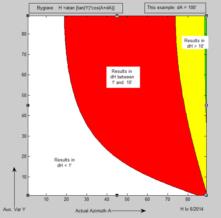
NavList:
A Community Devoted to the Preservation and Practice of Celestial Navigation and Other Methods of Traditional Wayfinding
From: Hanno Ix
Date: 2014 Jun 11, 20:05 -0700
formula and his design. Since nobody on the list answered
log10(sin(x)) - scale and the length of a log10(tan(x)) - scale
a comfortable reading. However, I will not argue against "2mm per arcmin"
The lengths came out as:
log10(sin(x)) 64 meters log10(tan(x)) 28 meters.
with the cos() - scale about half as far or less. Why, then, can the FB yield - occasionally at least - a result with an error of 2 arc min or less as G. LaPook reports?
In fact, on the copy of the FB in my possession, at ~45 deg on the tan() scale you can at discern 1 arcmin with ease - outside much less.
Getting closer to the real question: In the FB, the cos() scale has been shrunk far below that "1mm per 1 arcmin" threshold. Look at the 5 deg area! Why is the result still as good as Gary et al. claim? In other words, why does that very rough cos() scale not prevent the overall results to be so close to the correct one? That is odd!
Thanks Hanno.
Good challenge. Hospital next week. Out of action maybe 4 weeks, then ok for go. !
My slide rules cost about $5 a piece so far, but plenty of work!
Can be done.
Keep up the interesting work. My money is on Bygrave, but I’m biased!
Francis
From: NavList@fer3.com [mailto:NavList@fer3.com] On Behalf Of Hanno Ix
Sent: 11 June 2014 17:01
To: francisupchurch---.com
Subject: [NavList] Re: Longhand Sight Reduction
Francis,
Given the choice Danioli vs Bygrave: What would Chichester have chosen?Assuming, of course, he had access to and enough experience with both.
I celebrated Greg's RIC / Danioli yesterday by playing around with it.
It indeed works and is fast. Comparison with the standard formula is attached below.
Greg seems to think one can do that single multiplication with a 10" slide rule.
I am skeptic. In praxis, ten inchers do not yield correct 4 digits consistently,
and that's what I need for accuracy over the useful ranges of L,D,t.Now, there might be a challenge especially for you: a Fuller < = 10" that can
- do 4 digit multiplication, i.e. yields vwxy = ABCD * abcd; v, w, x, y being correct digits.
- can be built with standard and garage tools plus a PC and printer.
- in not more than, say, a week.
- for about $50 or less, $100 max.
It need not look like an exhibit in a museum, although it should be sturdy enough
to survive a 1-week sailing trip in the Virgin Islands. ( Where and when can I sign up? )Re: formulas. One example, with good or flawed results, is not really sufficient to
judge a formula or method. You need to show it yields accurate 4 digit results consistently
for the full useful ranges of L,D,t. I am unsure, though, what "useful" means for our CelNav friends.Any ideas out there?
I am studying the Bygrave in this respect right now. Stand by please.
Hanno
_____________________________________________________________________________________For the record, Danioli claims:
sin(h) = n - ( n + m ) * a ; n: cos(L-D); m: cos(L+D); a: [1 - cos(t) ] / 2 or hav(t);
Let's see. By inserting:sin(h) = cos(L-D) - [ cos(L-D) + cos(L+D) ] * [ 1 - cos(t) ] / 2;
which is in more detail:
sin(h) = cos(L-D) - cos(L-D) * [ 1 - cos(t) ] / 2 - cos(L+D) * [1 - cos(t) ] / 2;
and more detail yet:
sin(h) = cos(L-D) - cos(L-D) / 2 + cos(L-D)*cos(t) / 2 - cos(L+D) / 2 + cos(L+D)*cos(t) / 2;
Collecting:
sin(h) = cos(L-D)/2 - cos(L+D) / 2 + [ cos(L-D) / 2 + cos(L+D) / 2 ] * cos(t);
= sin(L) * sin(D) + cos(L) * cos(D) * cos(t);
which is correct.
On Tue, Jun 10, 2014 at 11:11 PM, Francis Upchurch <NoReply_Upchurch@fer3.com> wrote:
Oh dear. Is it time to put my beloved Bygrave away? Cant wait to here more details of the Bygrave maths.Chichester said he preferred the Bygrave when flying single handed, because he made mistakes with log tables. (Perhaps he did not have Haversines?) But, could someone explain the main difference/advantages/disadvantages of the versine method (Vers ZD=Vers LHAxCos Latx Cos Dec+Vers(Lat+/-Dec) and the Haversine method? My versine method (Reeds Astro Nav Tables) uses tables of natural and log versines and log cos (total 11 pages).Does not need sines.
Versine method
log vers LHA 9.9019
log cos Lat 9.9177
log cos Dec 9.9642
add 29.7838
Nat Vers of 9.7838= 0.6081
Lat-Dec=11013' Nat vers=0.0191. Add= 0.6272=6806'. =ZD. 900-6806'= 21054'
Not a lot in it I would say? quicker for me than reduction tables and I understand what we are doing.
Please correct me and explain the advantages of the Haversine over the versine. (I do not have haversines but do have versines! Where do I get haversines?)
Bygrave. H=3600-LHA=78021', co-lat=55050', y(w)=64031', X=colat+y(w)=120021', Y=1800-X=59039', > Az =76024'> Hc 21054'
No contest! Took a fraction of the time and no mistakes from looking up 4 figure logs etc. And I've got Az (OK done hundreds of Bygrave LOPs and only a couple of Versines!)
I'll stick to my Bygrave!








